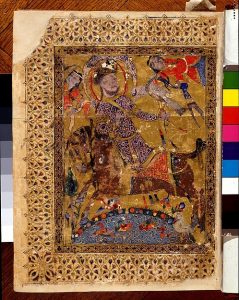Last updated: April 16th, 2025 at 12:21 pm · Est. Reading Time: 3 minutes
There are four kinds of primary sources available to compile the history of pre-Islamic Arabia.
1: Inscriptions (naqsh نقش): They are thousands of texts written by both common people as well as the leaders. Most of them are engraved on mountain rocks. Some are on other materials like funerary slabs, lintel and walls of houses, walls of churches etc.

3: Pre-Islamic Arabic poetry: A lot of skepticism persists about the use of pre-Islamic Arabic poetry as a primary source of history. Many scholars of previous decades considered it a secondary source. Lately, frontline scholars are using it as a primary source to compile the history of pre-Islamic Arabia.
4: Extant texts of foreign scholars: Scholars of the Roman Empire and Byzantine Rome had an interest in Arabia. They have mentioned it fleetingly in their Greek and Latin books. Christian scholars of Syria and Iraq also mentioned Arabia in their Syriac language literature.
Mainly, two kinds of secondary sources are available to compile the history of pre-Islamic Arabia
1: Early Islamic scholars: They are the most used source, more than the primary sources. Earliest among them are the historians writing in 8th century CE.
2: Study of pre-oil Arab society: Pre-Oil Arabia had not changed much since antiquity. By studying its society, many a times, historians could draw parallels with pre-Islamic culture and norms.
Further reading
- J. Lyall, “Ancient Arabian Poetry as a Source of Historical Information,” Journal of the Royal Asiatic Society 46 (Jul. 1914): 61 – 73.
Taha Husayn, Fi’l-shi’r al-Jhili, Cairo: Dar al-Ma’arif, 1925 (in Arabic).
- Margoliouth, “The Origins of Arabic Poetry,” Journal of the Royal Asiatic Society 87, no. 3 (1925): 417 – 449.
Jonathan A.C. Brown, “The Social Context of Pre-Islamic Poetry: Poetic Imaginary and Social Reality in the Mu’allaqat,” Arab Studies Quarterly 25, no.3 (2003): 29-50.
‘Umar Farrūkh, Das Bild des Frūhislam in der arabischen Dichtung von der Higra bis zum tode ‘Umars: 1 – 23 DH./622 – 644 N. Ch, Leipzig: Pries, 1937. (PhD thesis, in German).
- T. Monroe, “Oral Composition in pre-Islamic Poetry,” Journal of Arabic Literature 3 (1972): 1 – 53.
Suzanne Pinckney Stetkevych, The Mute Immortals Speak: Pre-Islamic Poetry and the Poetics of Ritual. Ithaca, N.Y.: Cornell University Press, 1993
- Zwettler, The Oral Tradition of Classical Arabic Poetry: Its Character and Implications, (Columbus: Ohio State University Press, 1978): 12 – 14.
Roger Allen, The Arabic Literary Heritage: The Development of its Genres and Criticism, New York: Cambridge University Press, 1998.
Gert Brog, “Poetry as a Source for the History of Early Islam: The case of (al-) Abbās b. Mirdās”, Journal of Arabic and Islamic Studies 15 (2015): 137 – 163.
Robert G. Hoyland. Arabia and the Arabs: From the Bronze Age to the Coming of Islam (New York: Routledge, 2001), 10, 251.
James A. Bellamy, “Arabic Verses from The First/Second Century: The Inscription Of ‘En ‘Avdat”, Journal of Semitic Studies, 35, (Spring 1990): 73 – 79.
Robert B. Serjeant, “Haram and Hawtah, the Sacred Enclave in Arabia,” in Melanges Taha Husain, ed. Abd al-Rahman Badawi, (Cairo: Dar al Ma’aref, 1962), 41 -58.

End notes
- Grohmann dates it from 328 CE to 350 CE (Adolf Grohmann, Arabische Palaographie. II. Teil. (Graz: Bohlau in Kommission, 1971), Vol 94, P 14, 16). Translation: I rose and made all sorts of money; which no world-weary man has [ever] collected; I have collected gold and silver, I announce it to those who are fed up and unwilling (J. A. Bellamy, “Two Pre-Islamic Arabic Inscriptions Revised: Jabal Ramm And Umm Al-Jimal,” Journal Of The American Oriental Society, 108 (1988): 369 – 372).
- Ali I. Al-Ghabban, “The Kingdom of Saudi Arabia and its Heritage,” in Roads of Arabia, ed. ‘Ali ibn Ibrāhīm Ghabbān, Beatrice Andre-Salvini, Francoise Demange, Carine Juvin and Marianne Cotty, (Paris: Louvre, 2010), 35.
- Fragment of kitāb al ʾAghānī: 1217 – 19. Current location: Royal Library Copenhagen, David Collection. DI/1990 (Royal Library Cod. Arab. CLXVIII).